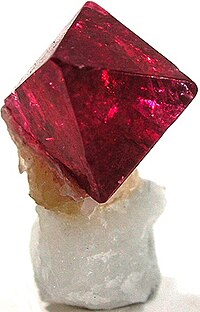
Photo from wikipedia
Petrological and geothermobarometric data from (garnet)-spinel peridotite and pyroxenite xenoliths in Quaternary alkali-basalts at Mega (Sidamo region, Ethiopia) provide evidence for refertilization and thinning of the lower subcontinental lithospheric mantle… Click to show full abstract
Petrological and geothermobarometric data from (garnet)-spinel peridotite and pyroxenite xenoliths in Quaternary alkali-basalts at Mega (Sidamo region, Ethiopia) provide evidence for refertilization and thinning of the lower subcontinental lithospheric mantle (SCLM) during Tertiary rifting events in the southern Main Ethiopian Rift (MER). Samples of lherzolites, harzburgites, and olivine websterites contain spinel-pyroxene symplectites that were formed by garnet breakdown reactions. P-T equilibration conditions, in part calculated using the reconstructed garnet composition (pyrope), indicate the evolution of peridotites from the P-T conditions from the garnet stability field (2.9–2.2 GPa; 945–1025 °C), through garnet-spinel transition (< 2.1–1.7 GPa at 906–1017 °C), to the final equilibration in the spinel stability field (1.3 GPa at 862–1056 °C), corresponding to a nearly adiabatic decompression path of about 50 km. Peridotite chemical compositions plot in an off-craton trend, with variable fertility degrees, only in part due to partial melting processes. Rocks show variable CaO contents (0.96–4.12 wt%), CaO/Al2O3 ratios (1.42–4.46), and clinopyroxene contents (6–31 vol.%), reaching compositions more enriched than pyrolite. Clinopyroxene shows evident LREE, U, Th, and Sr enrichments, particularly in harzburgites. Geochemical data suggest heterogeneous refertilization of a refractory lower SCLM, induced by infiltration and migration through porous flow of silicate-carbonate melts. Metasomatic processes drove melt compositions towards low-viscosity highly-mobile C-O-H-rich melts, inducing cryptic and hydrous modal metasomatism in refractory peridotites. Heterogeneous refertilization of the SCLM beneath the southern MER seems to have been induced by upwelling of asthenospheric melts and/or by reactivation of ancient lithospheric metasomes. Rejuvenation processes could have rheologically weakened the base of SCLM through gravitational instabilities, and increased the extensional stresses, causing a destabilizing effect at the onset of the lithospheric thinning and Tertiary rifting.
Journal Title: Chemical Geology
Year Published: 2017
Link to full text (if available)
Share on Social Media: Sign Up to like & get
recommendations!